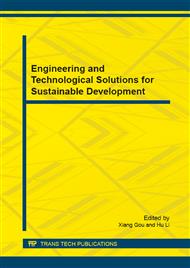p.187
p.193
p.200
p.205
p.211
p.218
p.222
p.227
p.231
Energy-Saving Analysis and Heat Transfer Performance of Wastewater Source Heat Pump
Abstract:
There is a large potential in the heat loss from the urban wastewater. In all kinds of low-grade heat sources, urban wastewater is gradually widely used because of its advantages such as huge quantities, small variation of temperature, warm in winter and cool in summer, etc. By integrating a heat pump to utilize this heat, the wastewater source heat pump (WWSHP), which is a new water reuse and treatment strategy to tackle the water problems of China and to realize the sustainable development, recovers the heat of wastewater. The WWSHP air conditioning system as residential application can reduce the need of energy systems based on fossil fuel for cooling, heating, and hot water's supply purposes. The system's working principle, classification and the wastewater's characteristic parameters were discussed in this paper. And the scheme of using WWSHP system for central air-conditioning compared with other refrigerating and heating equipments was analyzed in detail. The investigation into COP (Coefficient of Performance) and PER (Primary Energy Ratio) was shown in this paper. Among the four kinds of common air conditioning units, when the loads are same respectively, the WWSHP has the most significant energy-saving effect. Furthermore, mechanism of heat transfer enhancement for falling-film evaporation and condensation surface of tubes packed with wire-mesh is also studied in detail. Theoretical simulation will be carried out for the heat transfer process and the flow of falling-film outside horizontal tubes. Improvement of controlling parameters influenced the evaporation and condensation performance, and then led to an increase in the refrigerating quantity and the COP. Consequently, this WWSHP system has its theoretical significance and promising engineering application potentials for the residential refrigerating and air-conditioning system using low-temperature waste heat source.
Info:
Periodical:
Pages:
211-217
Citation:
Online since:
November 2014
Authors:
Price:
Сopyright:
© 2014 Trans Tech Publications Ltd. All Rights Reserved
Share:
Citation:


